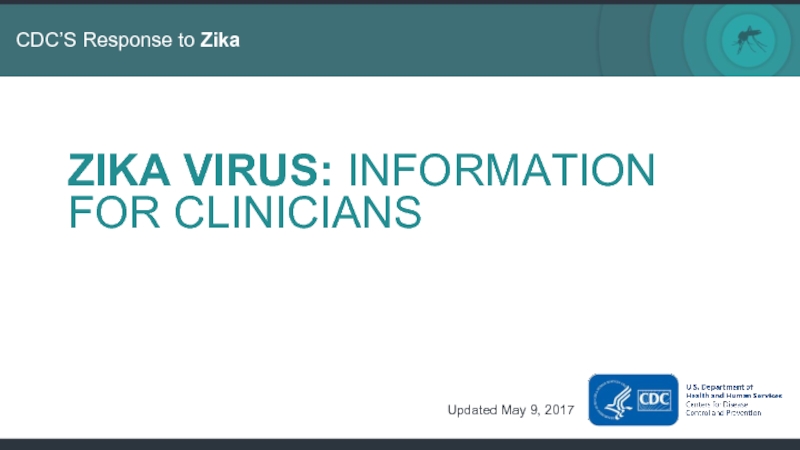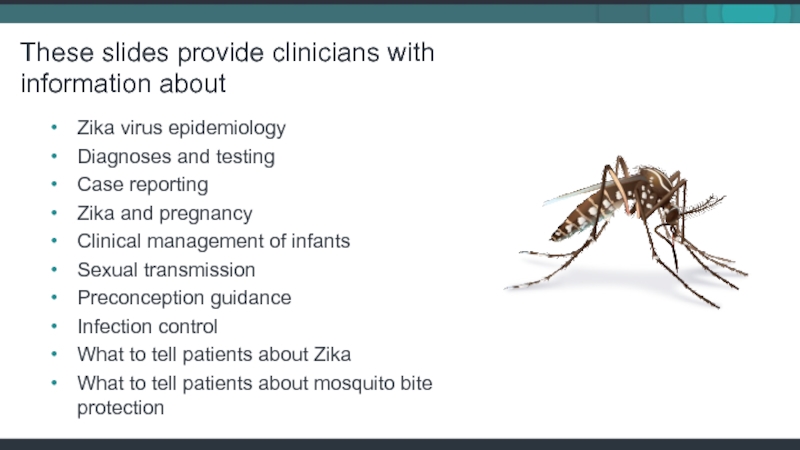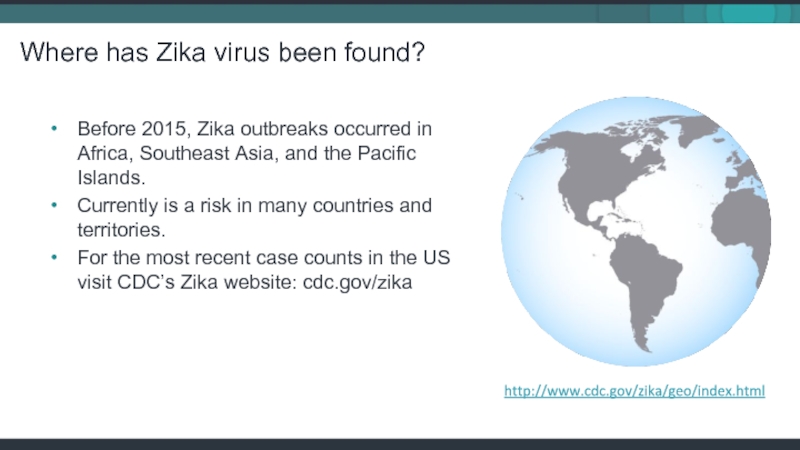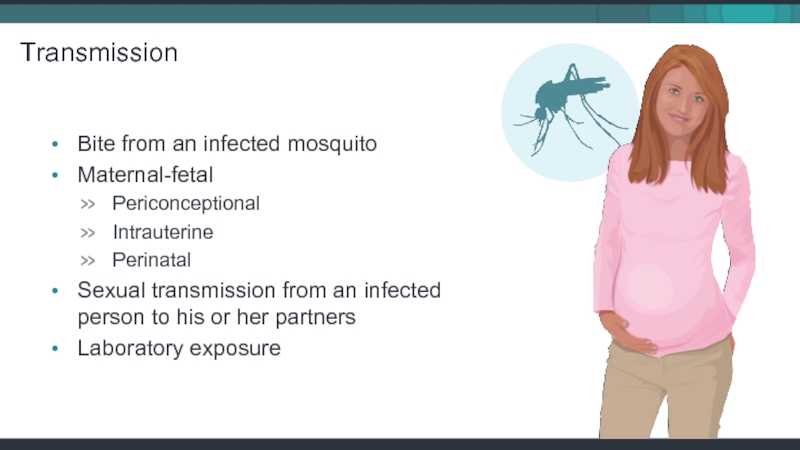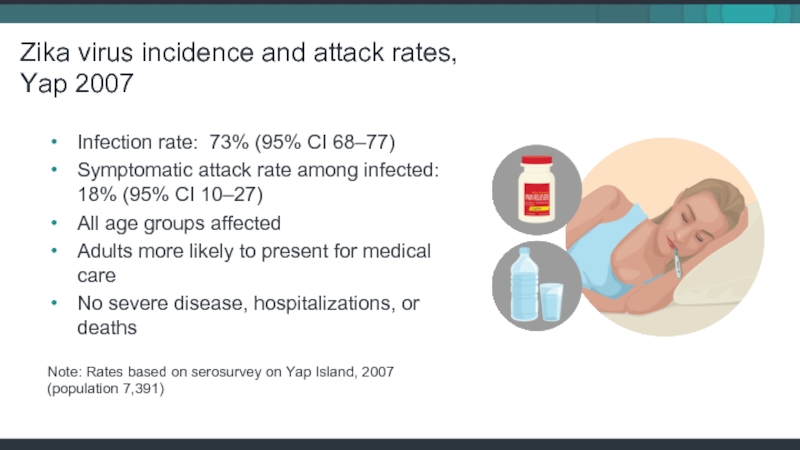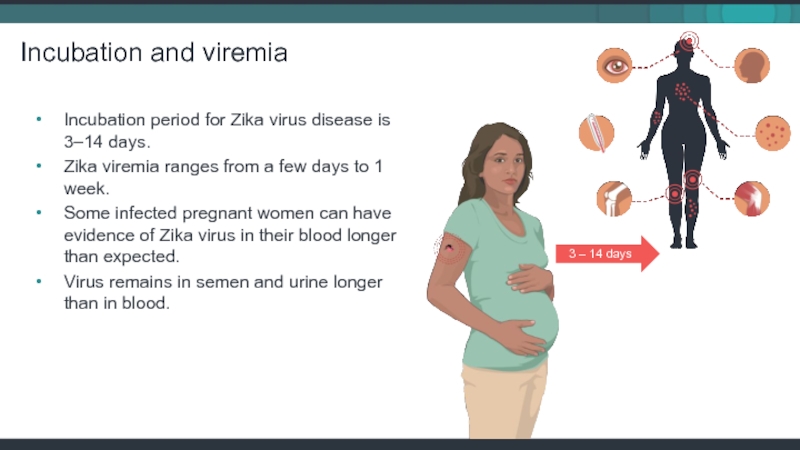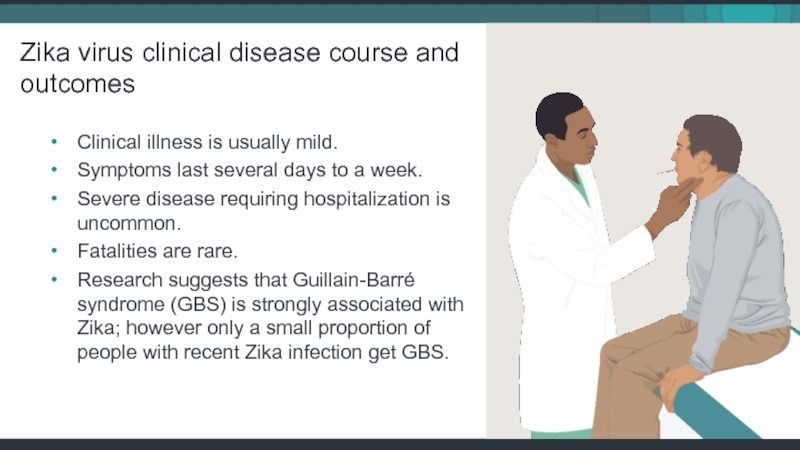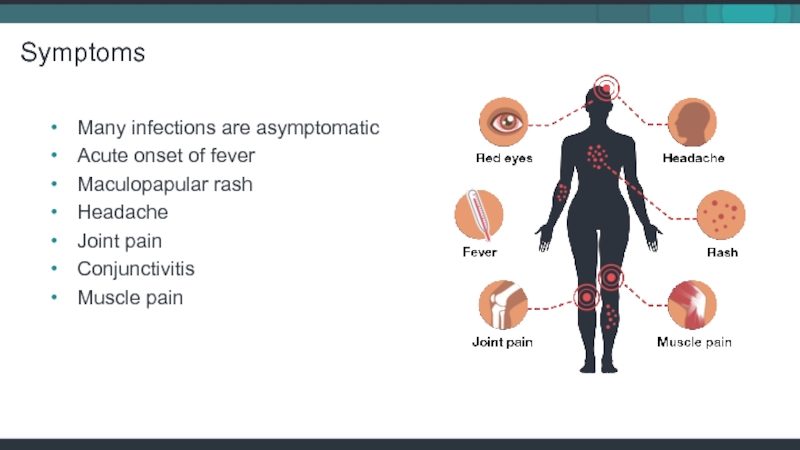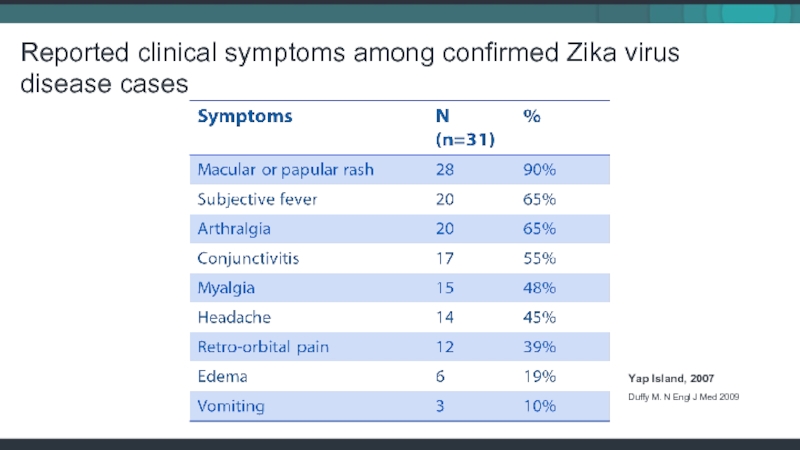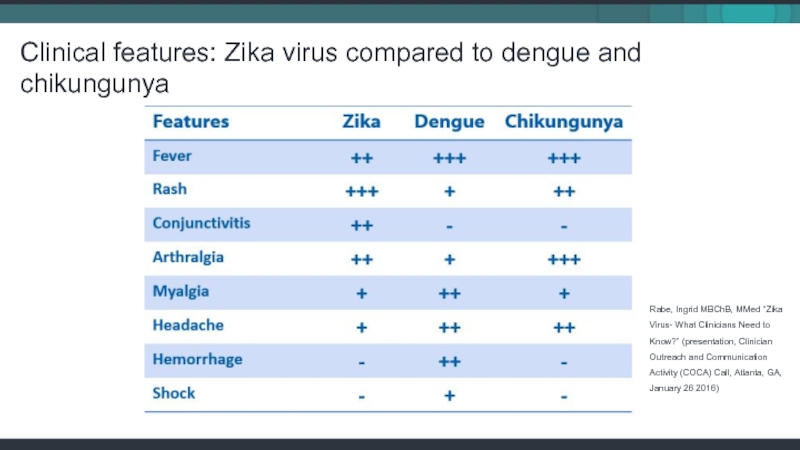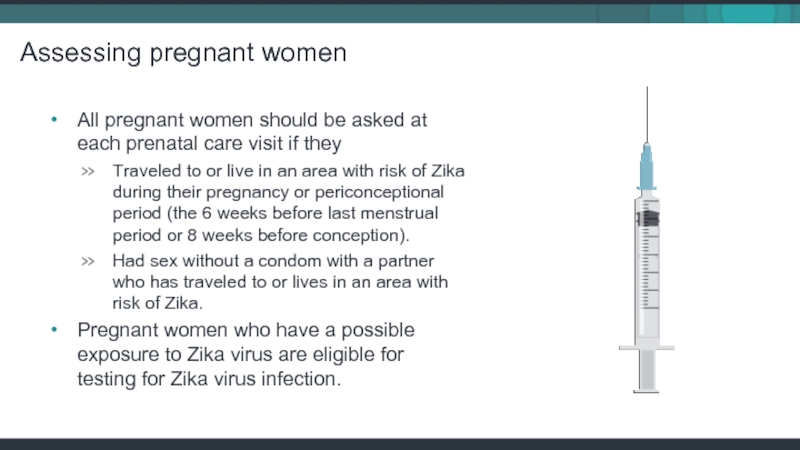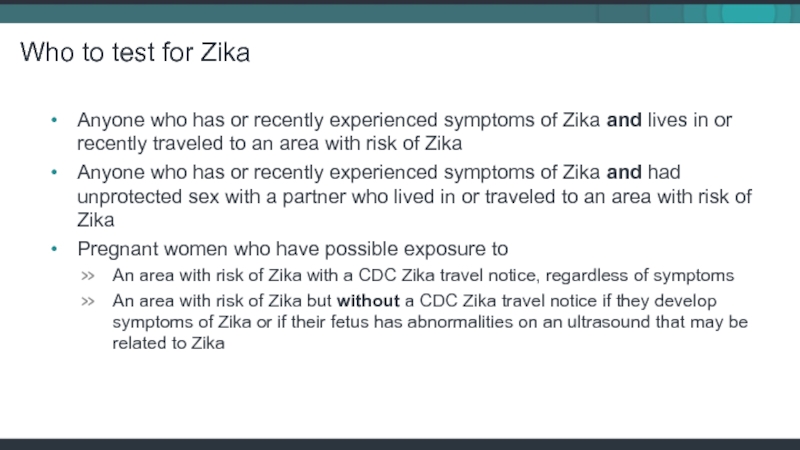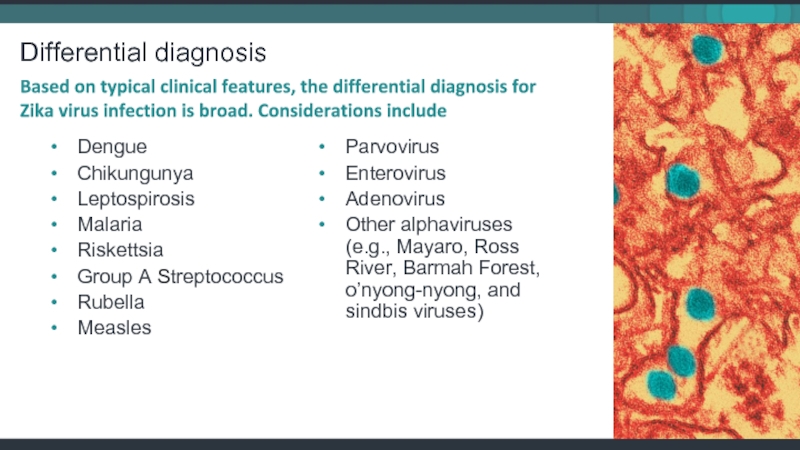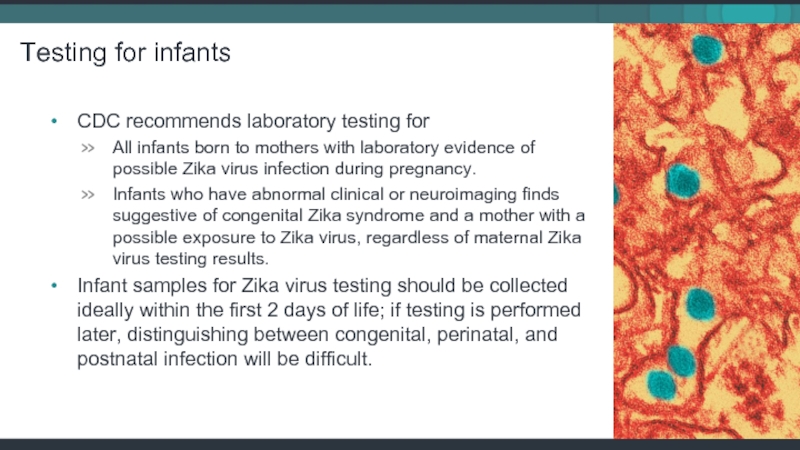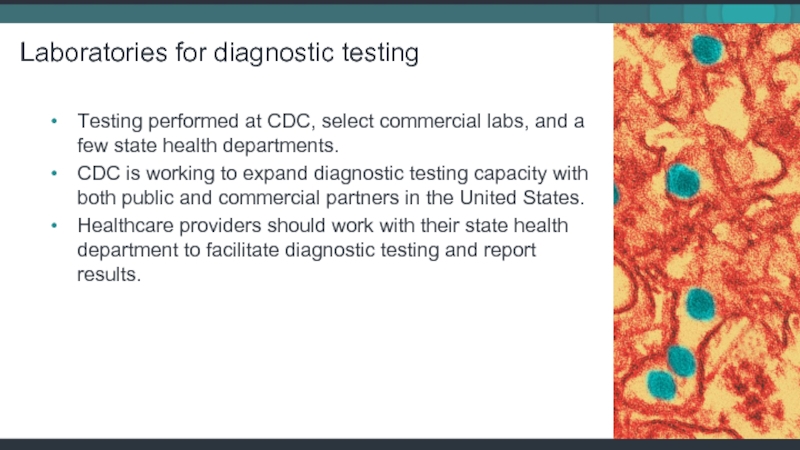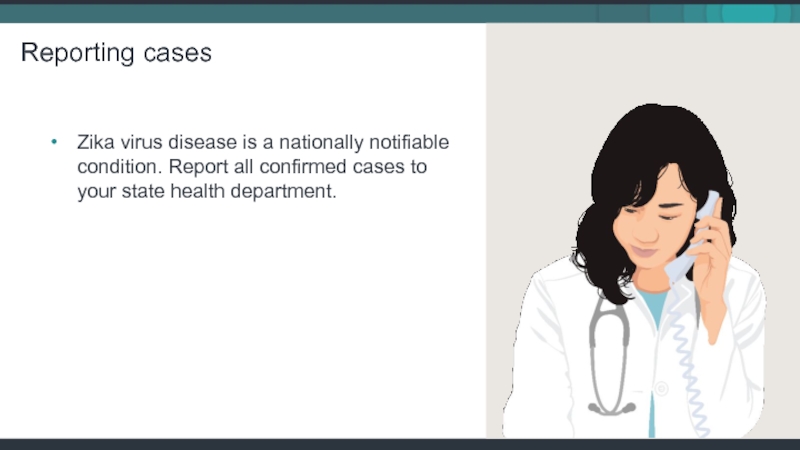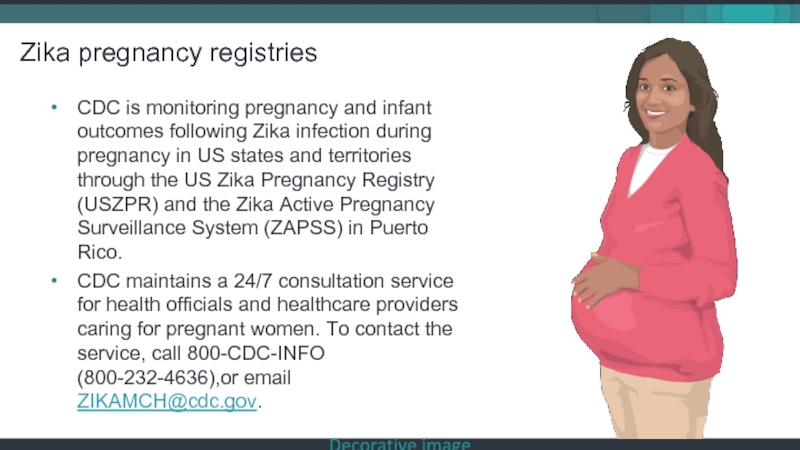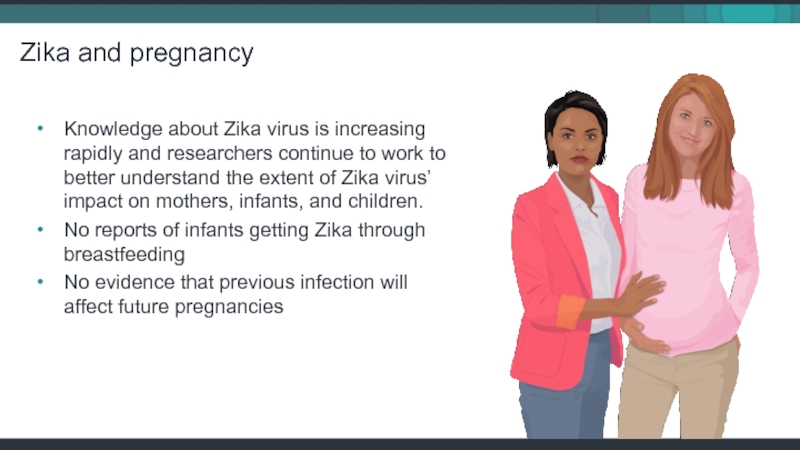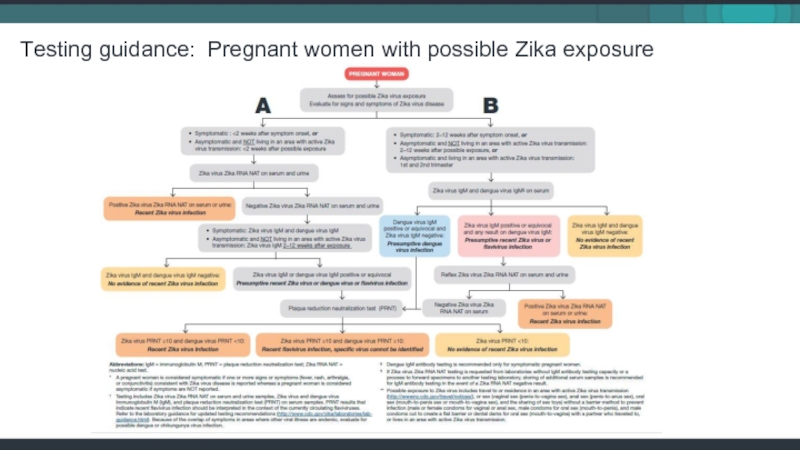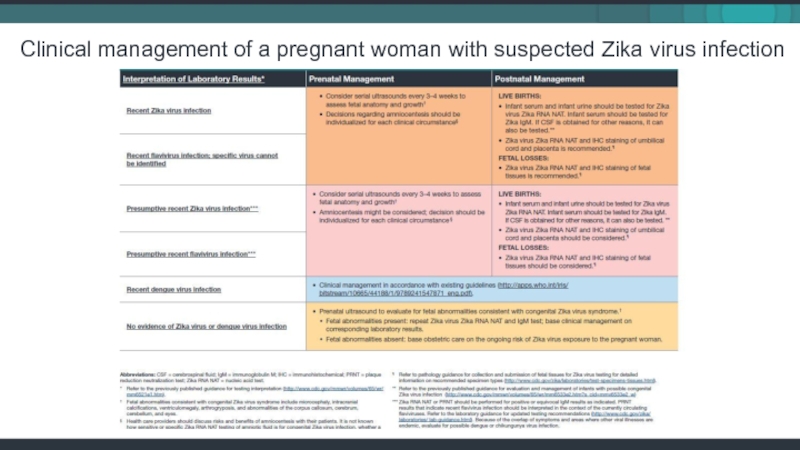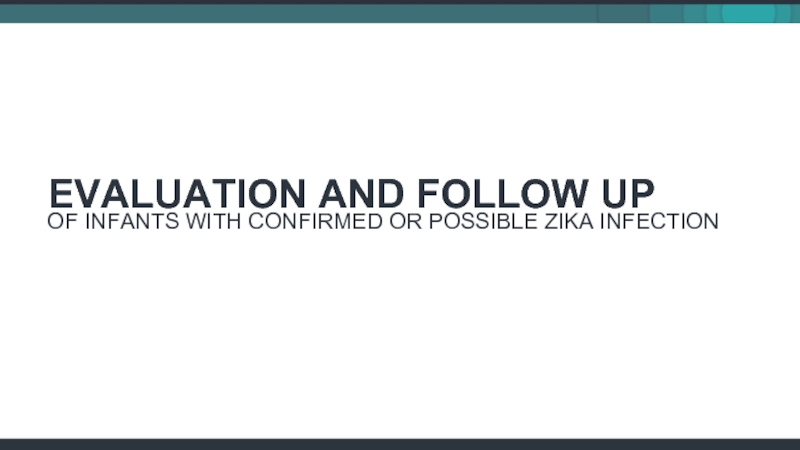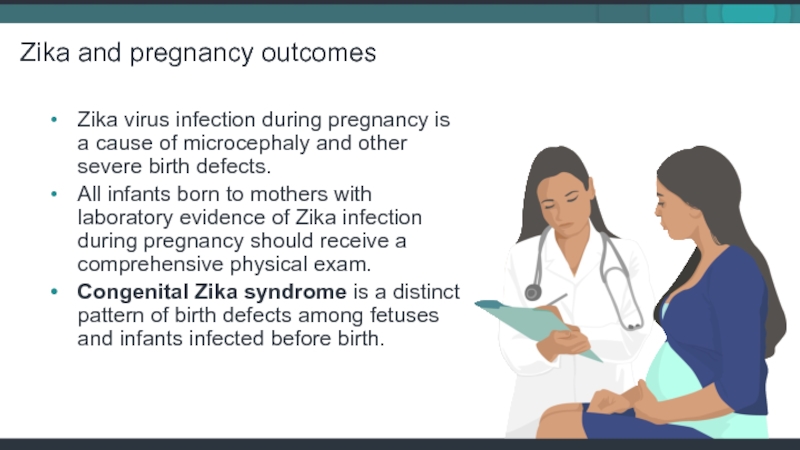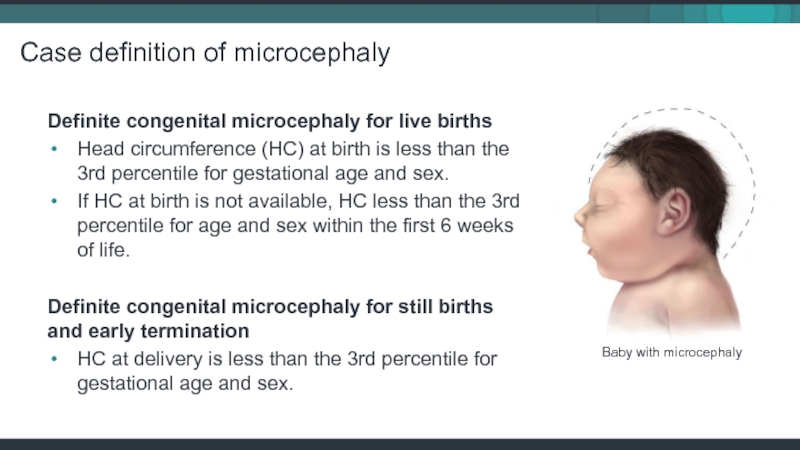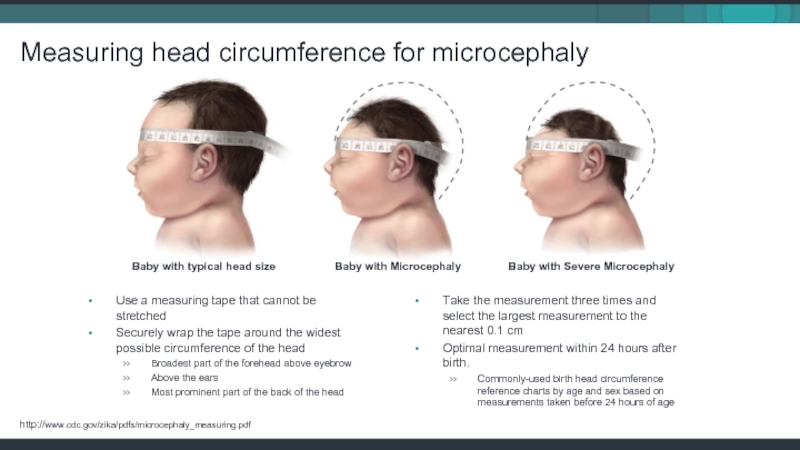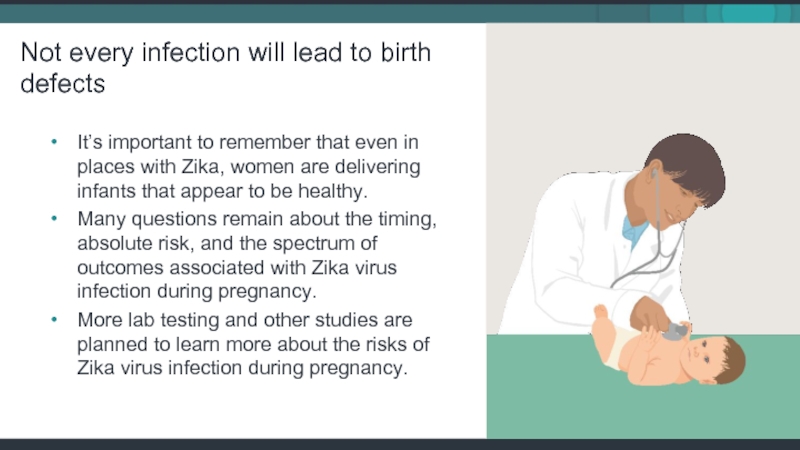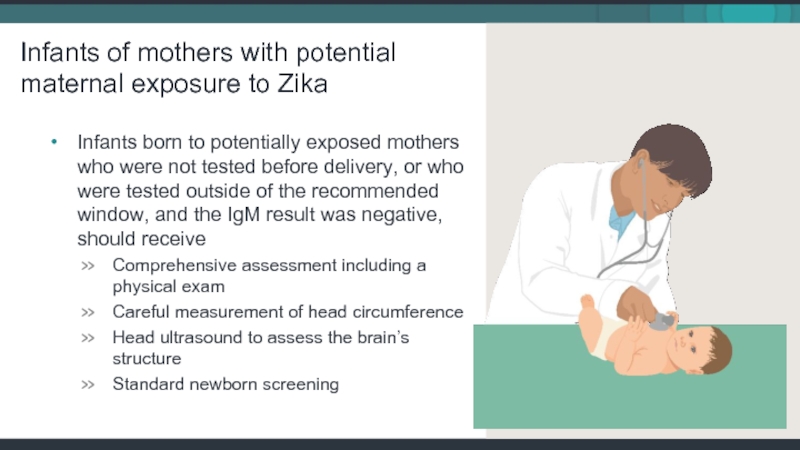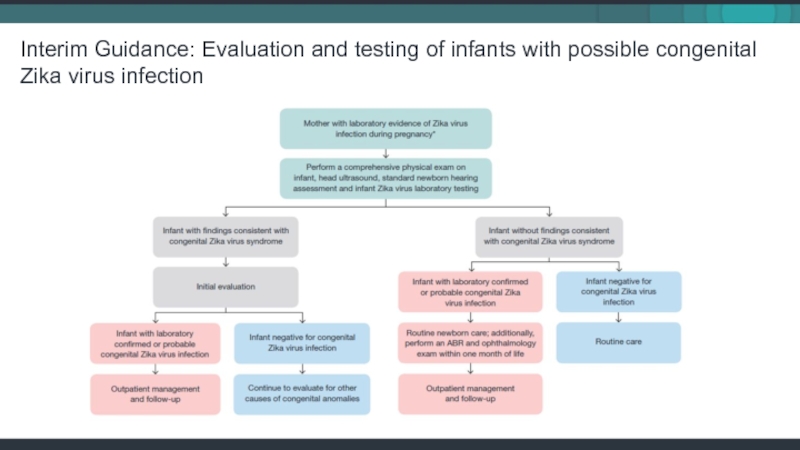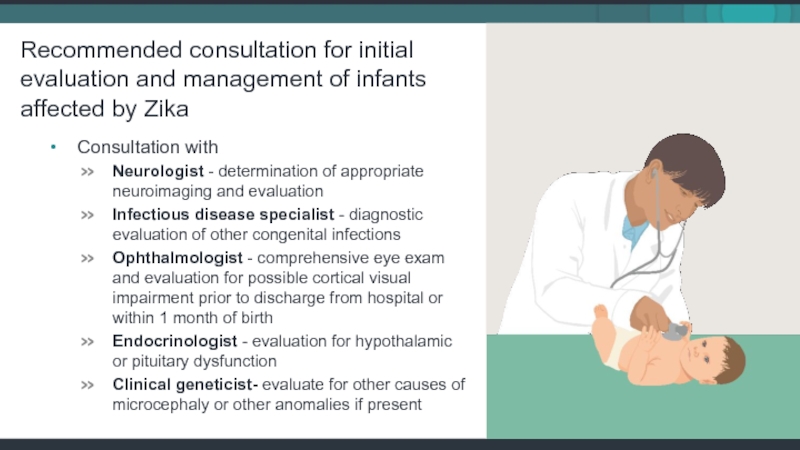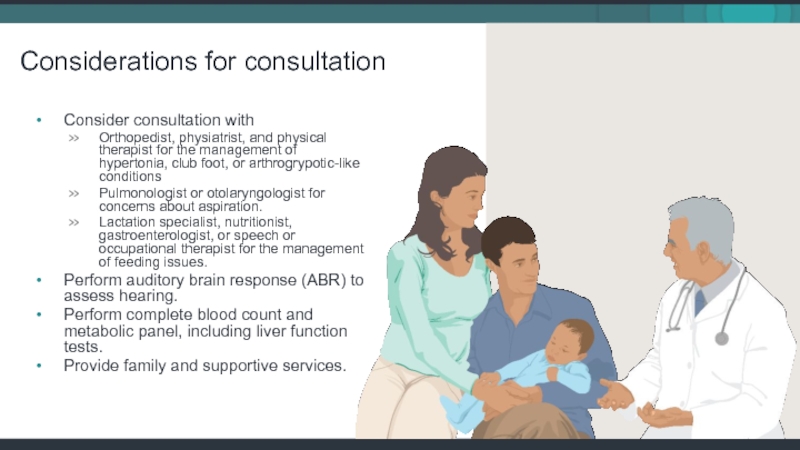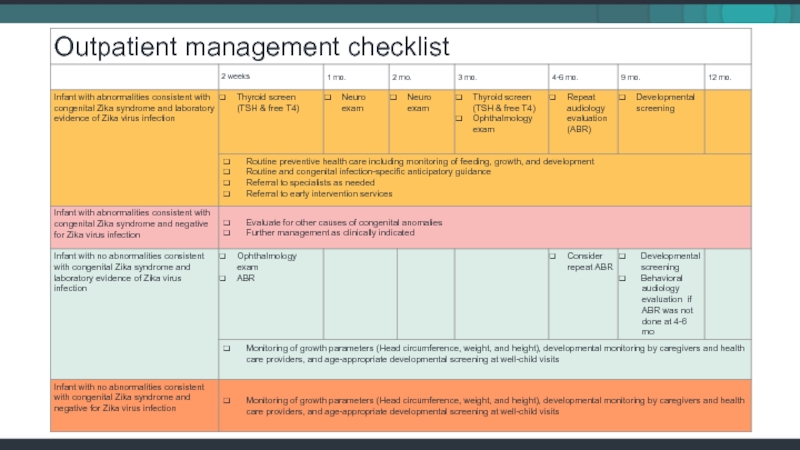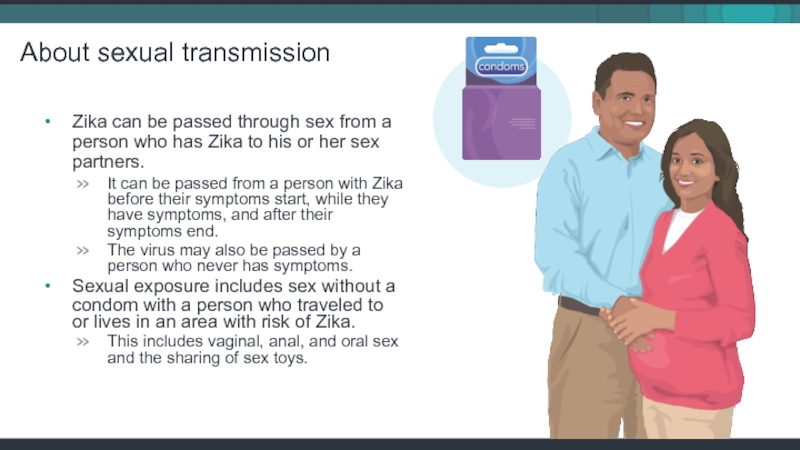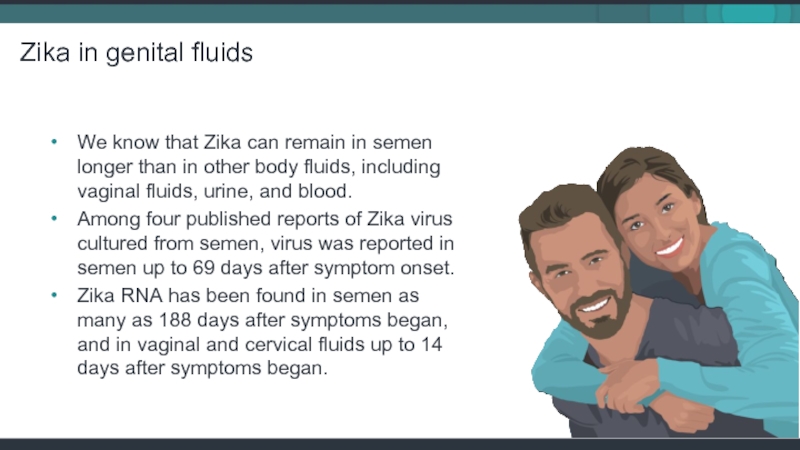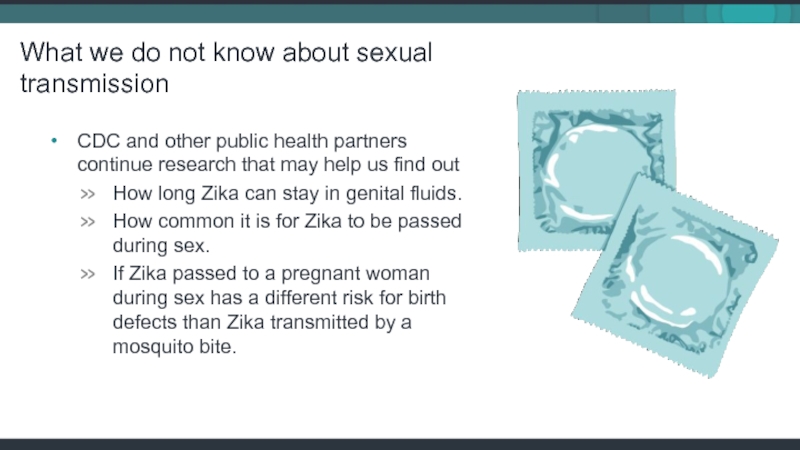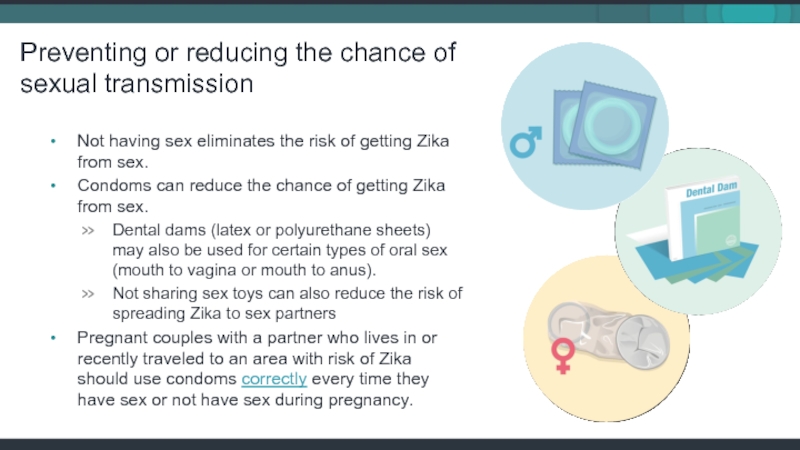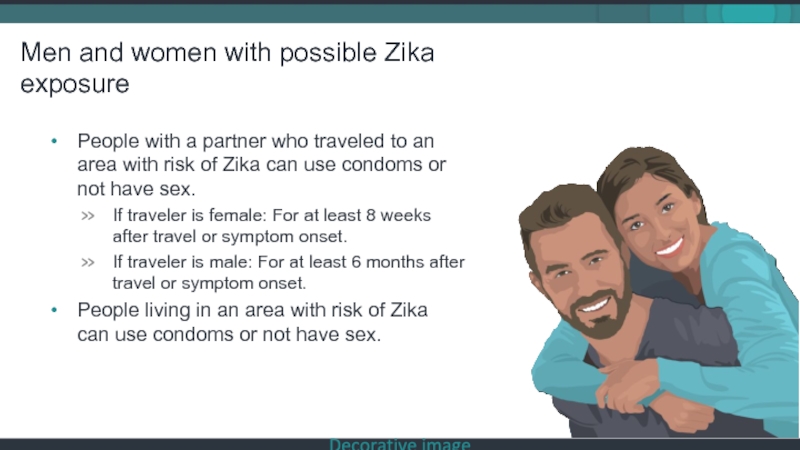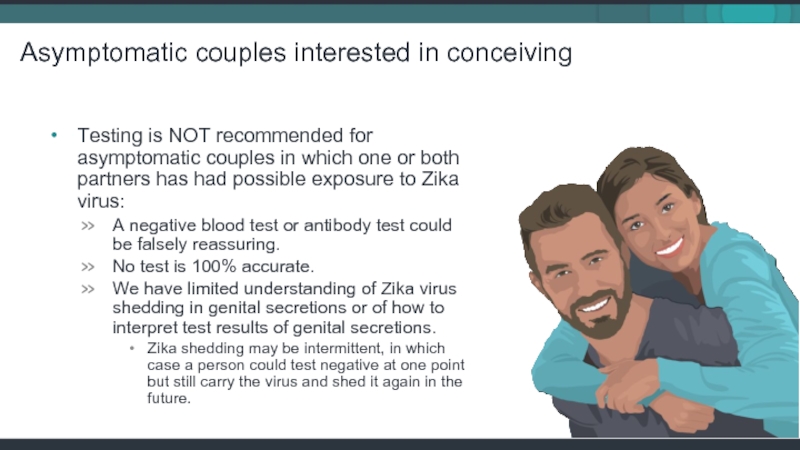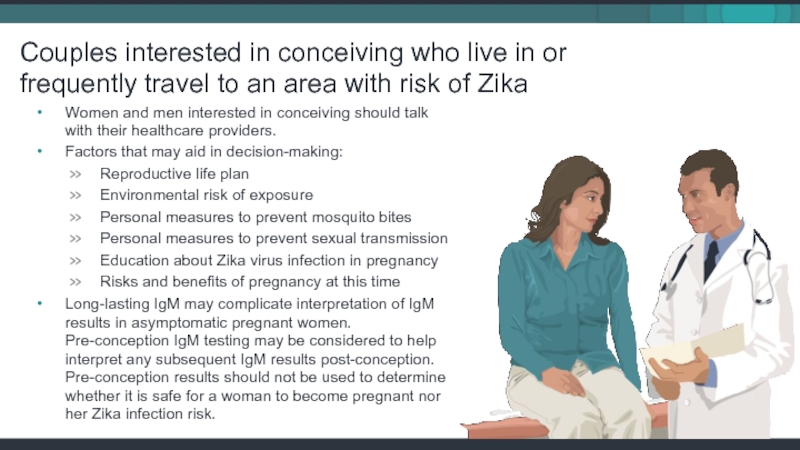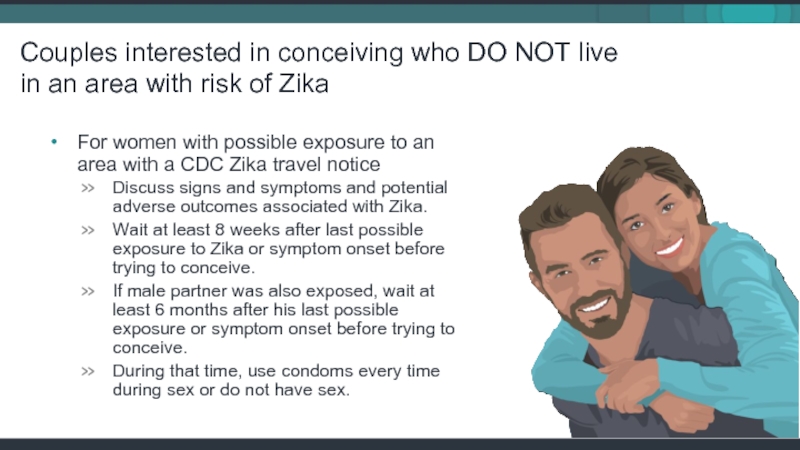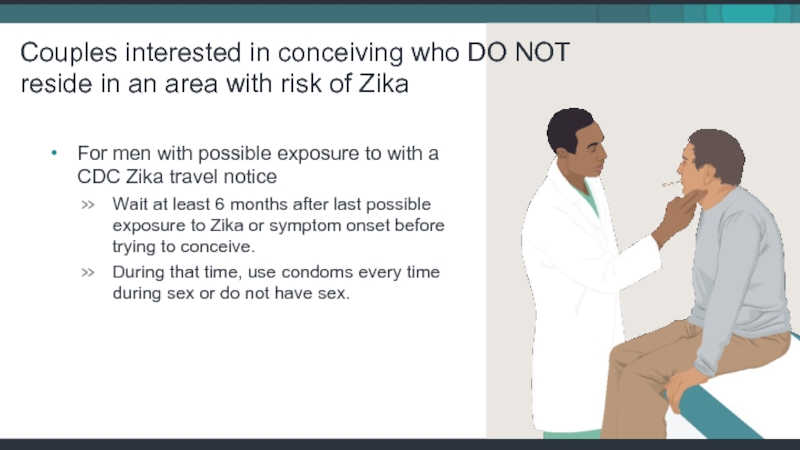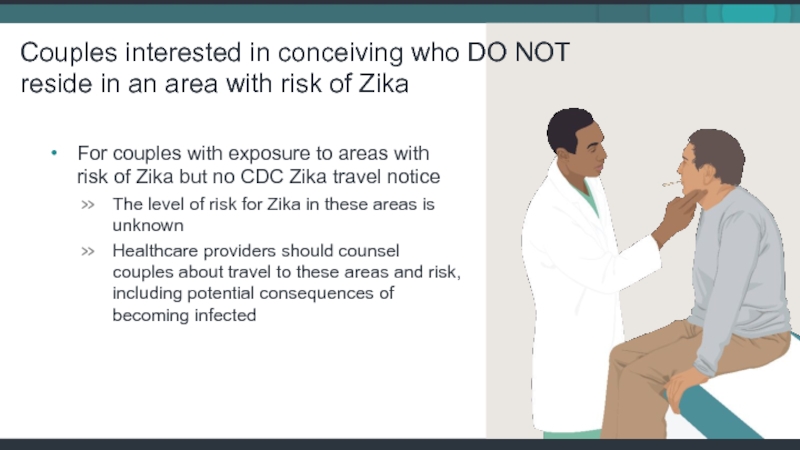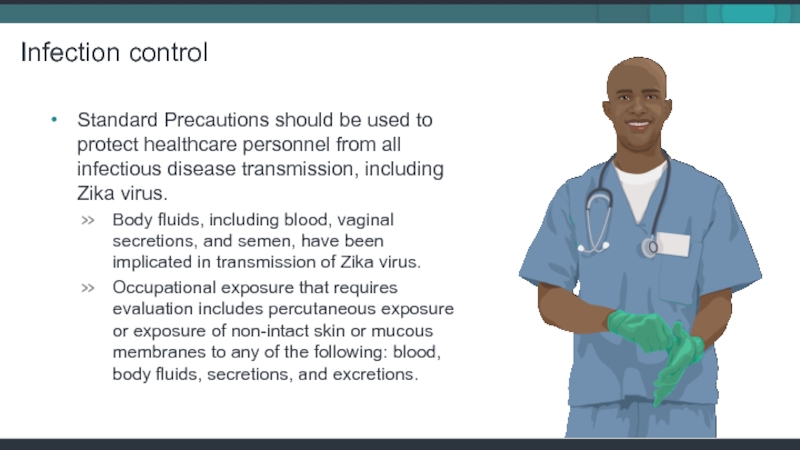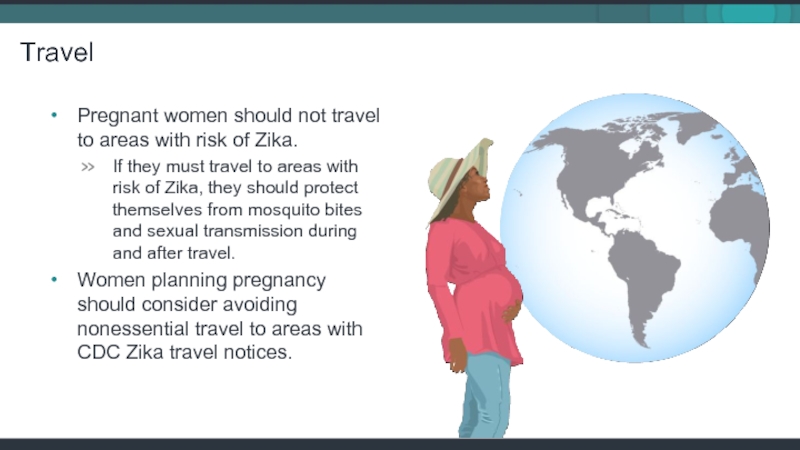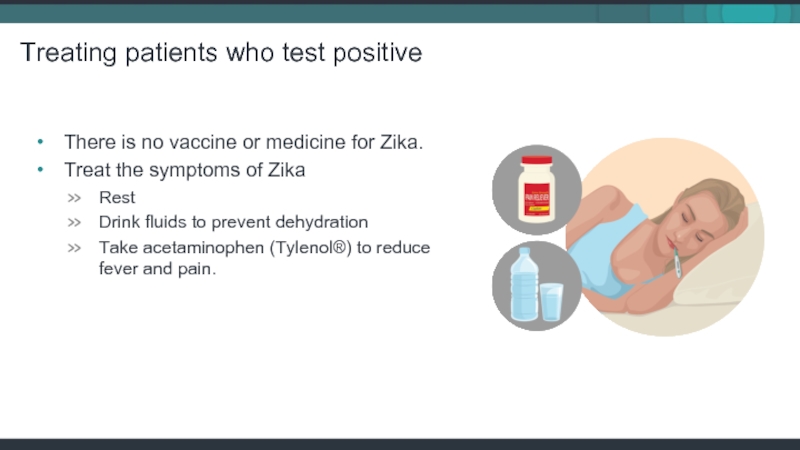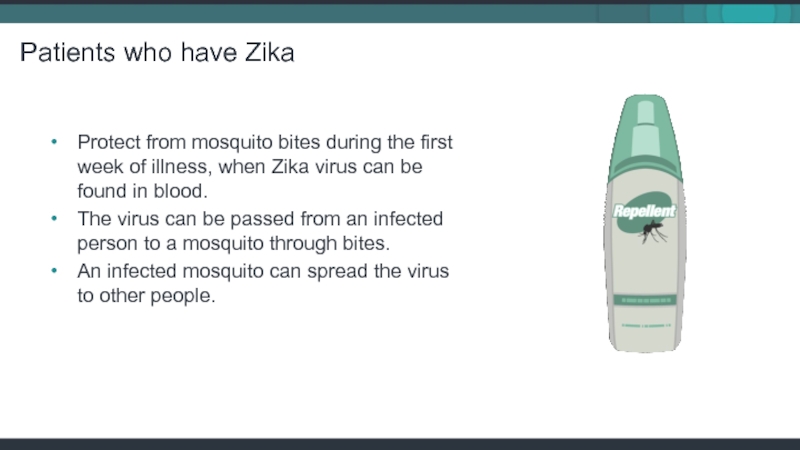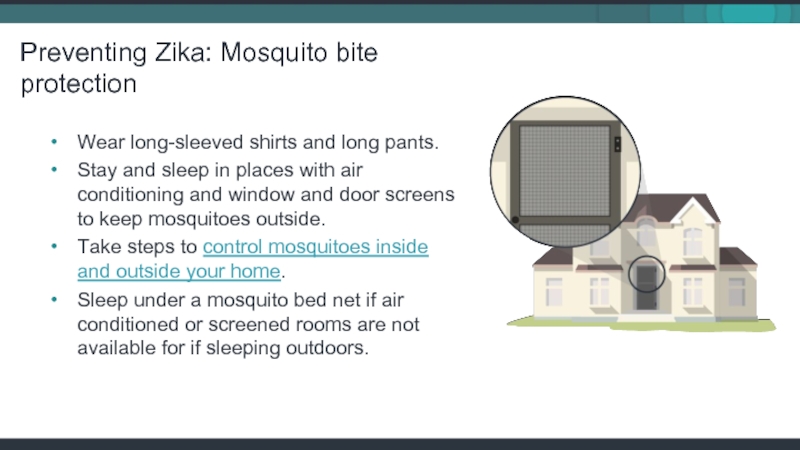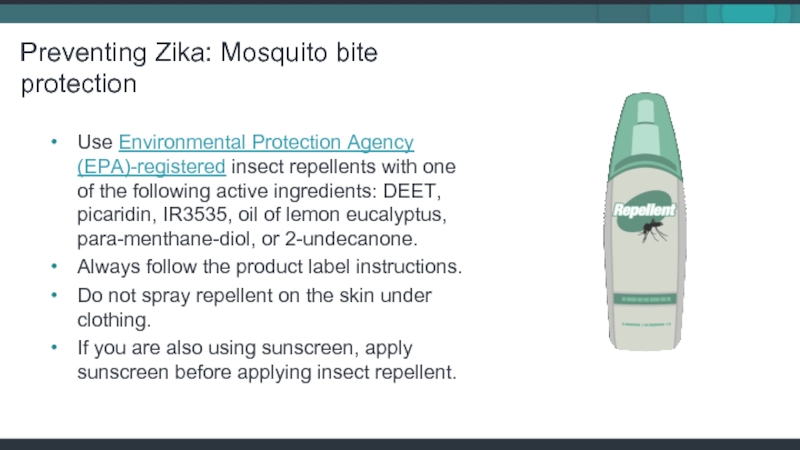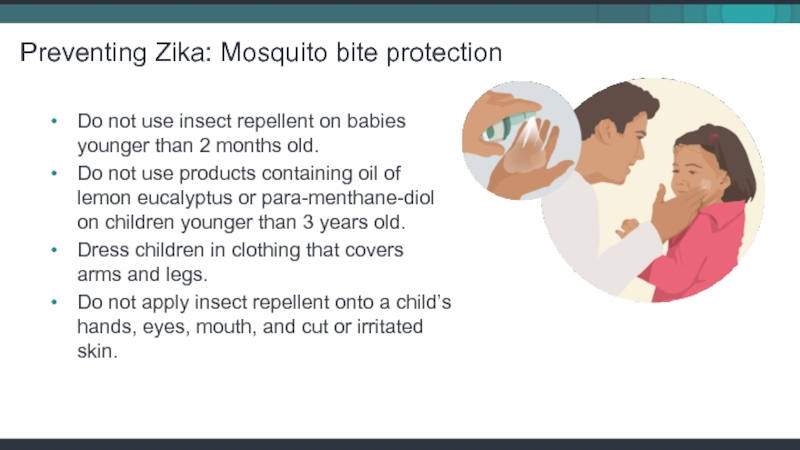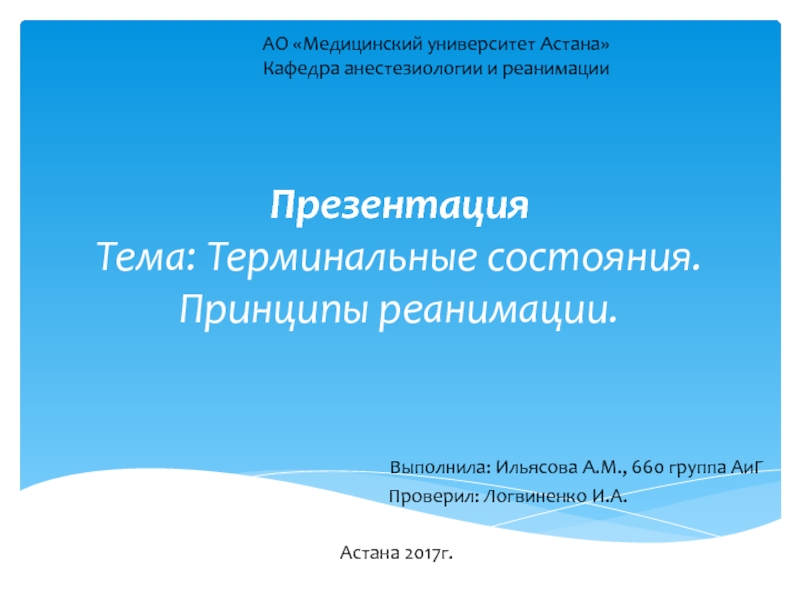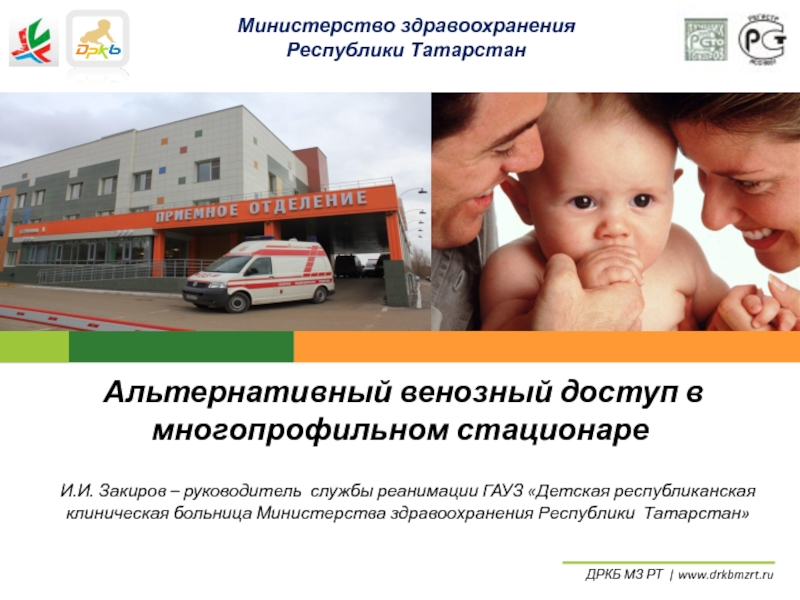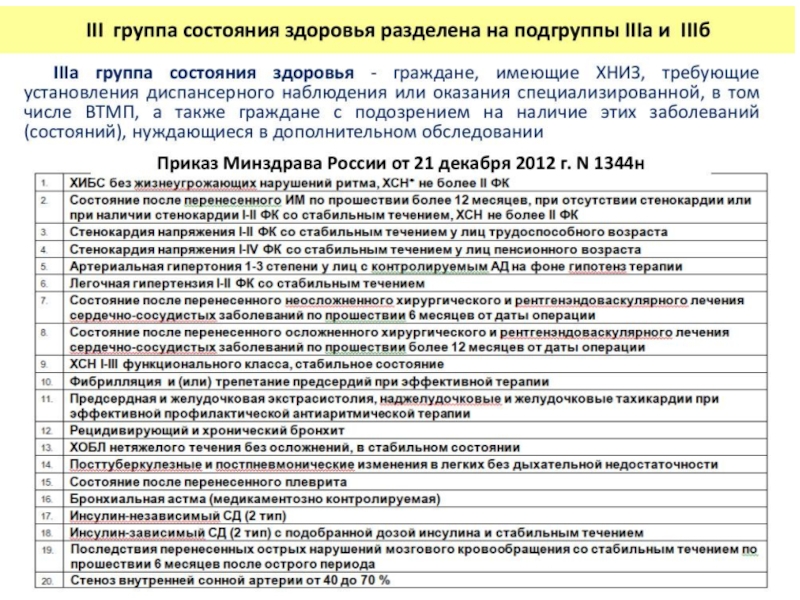- Главная
- Разное
- Дизайн
- Бизнес и предпринимательство
- Аналитика
- Образование
- Развлечения
- Красота и здоровье
- Финансы
- Государство
- Путешествия
- Спорт
- Недвижимость
- Армия
- Графика
- Культурология
- Еда и кулинария
- Лингвистика
- Английский язык
- Астрономия
- Алгебра
- Биология
- География
- Детские презентации
- Информатика
- История
- Литература
- Маркетинг
- Математика
- Медицина
- Менеджмент
- Музыка
- МХК
- Немецкий язык
- ОБЖ
- Обществознание
- Окружающий мир
- Педагогика
- Русский язык
- Технология
- Физика
- Философия
- Химия
- Шаблоны, картинки для презентаций
- Экология
- Экономика
- Юриспруденция
Zika virus: information for clinicians презентация
Содержание
- 1. Zika virus: information for clinicians
- 2. Zika virus epidemiology Diagnoses and testing Case
- 3. ZIKA VIRUS EPIDEMIOLOGY
- 4. Single stranded RNA virus Genus flavivirus, family
- 5. Before 2015, Zika outbreaks occurred in Africa,
- 6. Bite from an infected mosquito Maternal-fetal
- 7. Zika may be spread through blood transfusion.
- 8. Infection rate: 73% (95% CI 68–77) Symptomatic
- 9. Incubation period for Zika virus disease is
- 10. Clinical illness is usually mild. Symptoms last
- 11. Many infections are asymptomatic Acute onset of
- 12. Reported clinical symptoms among confirmed Zika virus
- 13. Clinical features: Zika virus compared to dengue
- 14. DIAGNOSES AND TESTING FOR ZIKA
- 15. All pregnant women should be asked at
- 16. Who to test for Zika Anyone who
- 17. Diagnostic testing for Zika virus During first
- 18. Differential diagnosis Dengue Chikungunya Leptospirosis Malaria Riskettsia
- 19. Serology cross-reactions with other flaviviruses Zika virus
- 20. Testing for infants CDC recommends laboratory testing
- 21. Laboratories for diagnostic testing Testing performed at
- 22. REPORTING ZIKA CASES
- 23. Zika virus disease is a nationally notifiable
- 24. CDC is monitoring pregnancy and infant outcomes
- 25. ZIKA AND PREGNANCY
- 26. Knowledge about Zika virus is increasing rapidly
- 27. Testing guidance: Pregnant women with possible Zika exposure
- 28. Clinical management of a pregnant woman with suspected Zika virus infection
- 29. EVALUATION AND FOLLOW UP OF INFANTS WITH CONFIRMED OR POSSIBLE ZIKA INFECTION
- 30. Zika virus infection during pregnancy is
- 31. Congenital Zika syndrome is associated with five
- 32. Case definition of microcephaly Definite congenital microcephaly
- 33. Definitions for possible congenital microcephaly Possible congenital
- 34. Measuring head circumference for microcephaly Use a
- 35. It’s important to remember that even in
- 36. Infants born to potentially exposed mothers who
- 37. Interim Guidance: Evaluation and testing of infants with possible congenital Zika virus infection
- 38. Consultation with Neurologist - determination of appropriate
- 39. Consider consultation with Orthopedist, physiatrist, and physical
- 41. Pediatric evaluation and follow up tools Download at: http://www.cdc.gov/zika/pdfs/pediatric-evaluation-follow-up-tool.pdf
- 42. SEXUAL TRANSMISSION
- 43. Zika can be passed through sex from
- 44. We know that Zika can remain in
- 45. CDC and other public health partners continue
- 46. Not having sex eliminates the risk of
- 47. Men and women with
- 48. PRECONCEPTION GUIDANCE
- 49. Testing is NOT recommended for asymptomatic couples
- 50. Women and men interested in conceiving should
- 51. For women with possible exposure to an
- 52. For men with possible exposure to with
- 53. For couples with exposure to areas with
- 54. INFECTION CONTROL IN HEALTHCARE SETTINGS
- 55. Standard Precautions should be used to protect
- 56. Healthcare personnel should assess the likelihood of
- 57. WHAT TO TELL PATIENTS ABOUT ZIKA
- 58. Pregnant women should not travel to areas
- 59. There is no vaccine or medicine for
- 60. Protect from mosquito bites during the first
- 61. Wear long-sleeved shirts and long pants. Stay
- 62. Use Environmental Protection Agency (EPA)-registered insect repellents
- 63. Preventing Zika: Mosquito bite protection Do not
- 64. Additional resources http://www.cdc.gov/zika http://www.cdc.gov/zika/hc-providers/index.html
Слайд 2Zika virus epidemiology
Diagnoses and testing
Case reporting
Zika and pregnancy
Clinical management of infants
Sexual
Preconception guidance
Infection control
What to tell patients about Zika
What to tell patients about mosquito bite protection
These slides provide clinicians with information about
Слайд 4Single stranded RNA virus
Genus flavivirus, family Flaviviridae
Closely related to dengue, yellow
Primarily transmitted through the bite of an infected Aedes species mosquito (Ae. aegypti and Ae. albopictus)
Zika Virus (Zika)
Aedes aegypti
Aedes albopictus
Слайд 5Before 2015, Zika outbreaks occurred in Africa, Southeast Asia, and the
Currently is a risk in many countries and territories.
For the most recent case counts in the US visit CDC’s Zika website: cdc.gov/zika
Where has Zika virus been found?
http://www.cdc.gov/zika/geo/index.html
Слайд 6Bite from an infected mosquito
Maternal-fetal
Periconceptional
Intrauterine
Perinatal
Sexual transmission from an infected person
Laboratory exposure
Transmission
Слайд 7Zika may be spread through blood transfusion.
Zika virus has been
There are no reports of transmission of Zika virus infection through breastfeeding.
Based on available evidence, the benefits of breastfeeding outweigh any possible risk.
Transmission
Слайд 8Infection rate: 73% (95% CI 68–77)
Symptomatic attack rate among infected: 18%
All age groups affected
Adults more likely to present for medical care
No severe disease, hospitalizations, or deaths
Note: Rates based on serosurvey on Yap Island, 2007 (population 7,391)
Zika virus incidence and attack rates, Yap 2007
Слайд 9Incubation period for Zika virus disease is 3–14 days.
Zika viremia ranges
Some infected pregnant women can have evidence of Zika virus in their blood longer than expected.
Virus remains in semen and urine longer than in blood.
Incubation and viremia
3 – 14 days
Слайд 10Clinical illness is usually mild.
Symptoms last several days to a week.
Severe disease requiring hospitalization is uncommon.
Fatalities are rare.
Research suggests that Guillain-Barré syndrome (GBS) is strongly associated with Zika; however only a small proportion of people with recent Zika infection get GBS.
Zika virus clinical disease course and outcomes
Слайд 11Many infections are asymptomatic
Acute onset of fever
Maculopapular rash
Headache
Joint pain
Conjunctivitis
Muscle pain
Symptoms
Слайд 12Reported clinical symptoms among confirmed Zika virus disease cases
Yap Island, 2007
Duffy
Слайд 13Clinical features: Zika virus compared to dengue and chikungunya
Rabe, Ingrid MBChB,
Слайд 15All pregnant women should be asked at each prenatal care visit
Traveled to or live in an area with risk of Zika during their pregnancy or periconceptional period (the 6 weeks before last menstrual period or 8 weeks before conception).
Had sex without a condom with a partner who has traveled to or lives in an area with risk of Zika.
Pregnant women who have a possible exposure to Zika virus are eligible for testing for Zika virus infection.
Assessing pregnant women
Слайд 16Who to test for Zika
Anyone who has or recently experienced symptoms
Anyone who has or recently experienced symptoms of Zika and had unprotected sex with a partner who lived in or traveled to an area with risk of Zika
Pregnant women who have possible exposure to
An area with risk of Zika with a CDC Zika travel notice, regardless of symptoms
An area with risk of Zika but without a CDC Zika travel notice if they develop symptoms of Zika or if their fetus has abnormalities on an ultrasound that may be related to Zika
Слайд 17Diagnostic testing for Zika virus
During first 2 weeks after the start
Serology assays can also be used to detect Zika virus-specific IgM and neutralizing antibodies, which typically develop toward the end of the first week of illness.
Plaque reduction neutralization test (PRNT) for presence of virus-specific neutralizing antibodies in serum samples.
Слайд 18Differential diagnosis
Dengue
Chikungunya
Leptospirosis
Malaria
Riskettsia
Group A Streptococcus
Rubella
Measles
Parvovirus
Enterovirus
Adenovirus
Other alphaviruses (e.g., Mayaro, Ross River, Barmah Forest,
Based on typical clinical features, the differential diagnosis for Zika virus infection is broad. Considerations include
Слайд 19Serology cross-reactions with other flaviviruses
Zika virus serology (IgM) can be positive
If Zika virus RNA NAT results are negative for both specimens, serum should be tested by antibody detection methods.
Neutralizing antibody testing by PRNT may discriminate between cross-reacting antibodies in primary flavivirus infections.
Difficult to distinguish Zika virus in people previously infected with or vaccinated against a related flavivirus.
Слайд 20Testing for infants
CDC recommends laboratory testing for
All infants born to
Infants who have abnormal clinical or neuroimaging finds suggestive of congenital Zika syndrome and a mother with a possible exposure to Zika virus, regardless of maternal Zika virus testing results.
Infant samples for Zika virus testing should be collected ideally within the first 2 days of life; if testing is performed later, distinguishing between congenital, perinatal, and postnatal infection will be difficult.
Слайд 21Laboratories for diagnostic testing
Testing performed at CDC, select commercial labs, and
CDC is working to expand diagnostic testing capacity with both public and commercial partners in the United States.
Healthcare providers should work with their state health department to facilitate diagnostic testing and report results.
Слайд 23Zika virus disease is a nationally notifiable condition. Report all confirmed
Reporting cases
Слайд 24CDC is monitoring pregnancy and infant outcomes following Zika infection during
CDC maintains a 24/7 consultation service for health officials and healthcare providers caring for pregnant women. To contact the service, call 800-CDC-INFO (800-232-4636),or email ZIKAMCH@cdc.gov.
Zika pregnancy registries
Decorative image
Слайд 26Knowledge about Zika virus is increasing rapidly and researchers continue to
No reports of infants getting Zika through breastfeeding
No evidence that previous infection will affect future pregnancies
Zika and pregnancy
Слайд 30
Zika virus infection during pregnancy is a cause of microcephaly and
All infants born to mothers with laboratory evidence of Zika infection during pregnancy should receive a comprehensive physical exam.
Congenital Zika syndrome is a distinct pattern of birth defects among fetuses and infants infected before birth.
Zika and pregnancy outcomes
Слайд 31Congenital Zika syndrome is associated with five types of birth defects
Severe microcephaly (small head size) resulting in a partially collapsed skull
Decreased brain tissue with brain damage (as indicated by a specific pattern of calcium deposits)
Damage to the back of the eye with a specific pattern of scarring and increased pigment
Limited range of joint motion, such as clubfoot
Too much muscle tone restricting body movement soon after birth
Congenital Zika syndrome
Слайд 32Case definition of microcephaly
Definite congenital microcephaly for live births
Head circumference (HC)
If HC at birth is not available, HC less than the 3rd percentile for age and sex within the first 6 weeks of life.
Definite congenital microcephaly for still births and early termination
HC at delivery is less than the 3rd percentile for gestational age and sex.
Baby with microcephaly
Слайд 33Definitions for possible congenital microcephaly
Possible congenital microcephaly for live births
If earlier
Possible microcephaly for all birth outcomes
Microcephaly diagnosed or suspected on prenatal ultrasound in the absence of available HC measurements.
Baby with microcephaly
Слайд 34Measuring head circumference for microcephaly
Use a measuring tape that cannot be
Securely wrap the tape around the widest possible circumference of the head
Broadest part of the forehead above eyebrow
Above the ears
Most prominent part of the back of the head
Take the measurement three times and select the largest measurement to the nearest 0.1 cm
Optimal measurement within 24 hours after birth.
Commonly-used birth head circumference reference charts by age and sex based on measurements taken before 24 hours of age
http://www.cdc.gov/zika/pdfs/microcephaly_measuring.pdf
Baby with typical head size
Baby with Microcephaly
Baby with Severe Microcephaly
Слайд 35It’s important to remember that even in places with Zika, women
Many questions remain about the timing, absolute risk, and the spectrum of outcomes associated with Zika virus infection during pregnancy.
More lab testing and other studies are planned to learn more about the risks of Zika virus infection during pregnancy.
Not every infection will lead to birth defects
Слайд 36Infants born to potentially exposed mothers who were not tested before
Comprehensive assessment including a physical exam
Careful measurement of head circumference
Head ultrasound to assess the brain’s structure
Standard newborn screening
Infants of mothers with potential maternal exposure to Zika
Слайд 37Interim Guidance: Evaluation and testing of infants with possible congenital Zika
Слайд 38Consultation with
Neurologist - determination of appropriate neuroimaging and evaluation
Infectious disease specialist
Ophthalmologist - comprehensive eye exam and evaluation for possible cortical visual impairment prior to discharge from hospital or within 1 month of birth
Endocrinologist - evaluation for hypothalamic or pituitary dysfunction
Clinical geneticist- evaluate for other causes of microcephaly or other anomalies if present
Recommended consultation for initial evaluation and management of infants affected by Zika
Слайд 39Consider consultation with
Orthopedist, physiatrist, and physical therapist for the management of
Pulmonologist or otolaryngologist for concerns about aspiration.
Lactation specialist, nutritionist, gastroenterologist, or speech or occupational therapist for the management of feeding issues.
Perform auditory brain response (ABR) to assess hearing.
Perform complete blood count and metabolic panel, including liver function tests.
Provide family and supportive services.
Considerations for consultation
Слайд 41Pediatric evaluation and follow up tools
Download at: http://www.cdc.gov/zika/pdfs/pediatric-evaluation-follow-up-tool.pdf
Слайд 43Zika can be passed through sex from a person who has
It can be passed from a person with Zika before their symptoms start, while they have symptoms, and after their symptoms end.
The virus may also be passed by a person who never has symptoms.
Sexual exposure includes sex without a condom with a person who traveled to or lives in an area with risk of Zika.
This includes vaginal, anal, and oral sex and the sharing of sex toys.
About sexual transmission
Слайд 44We know that Zika can remain in semen longer than in
Among four published reports of Zika virus cultured from semen, virus was reported in semen up to 69 days after symptom onset.
Zika RNA has been found in semen as many as 188 days after symptoms began, and in vaginal and cervical fluids up to 14 days after symptoms began.
Zika in genital fluids
Слайд 45CDC and other public health partners continue research that may help
How long Zika can stay in genital fluids.
How common it is for Zika to be passed during sex.
If Zika passed to a pregnant woman during sex has a different risk for birth defects than Zika transmitted by a mosquito bite.
What we do not know about sexual transmission
Слайд 46Not having sex eliminates the risk of getting Zika from sex.
Condoms
Dental dams (latex or polyurethane sheets) may also be used for certain types of oral sex (mouth to vagina or mouth to anus).
Not sharing sex toys can also reduce the risk of spreading Zika to sex partners
Pregnant couples with a partner who lives in or recently traveled to an area with risk of Zika should use condoms correctly every time they have sex or not have sex during pregnancy.
Preventing or reducing the chance of sexual transmission
Слайд 47
Men and women with possible Zika exposure
Decorative image
People with a partner
If traveler is female: For at least 8 weeks after travel or symptom onset.
If traveler is male: For at least 6 months after travel or symptom onset.
People living in an area with risk of Zika can use condoms or not have sex.
Слайд 49Testing is NOT recommended for asymptomatic couples in which one or
A negative blood test or antibody test could be falsely reassuring.
No test is 100% accurate.
We have limited understanding of Zika virus shedding in genital secretions or of how to interpret test results of genital secretions.
Zika shedding may be intermittent, in which case a person could test negative at one point but still carry the virus and shed it again in the future.
Asymptomatic couples interested in conceiving
Слайд 50Women and men interested in conceiving should talk with their healthcare
Factors that may aid in decision-making:
Reproductive life plan
Environmental risk of exposure
Personal measures to prevent mosquito bites
Personal measures to prevent sexual transmission
Education about Zika virus infection in pregnancy
Risks and benefits of pregnancy at this time
Long-lasting IgM may complicate interpretation of IgM results in asymptomatic pregnant women. Pre-conception IgM testing may be considered to help interpret any subsequent IgM results post-conception. Pre-conception results should not be used to determine whether it is safe for a woman to become pregnant nor her Zika infection risk.
Couples interested in conceiving who live in or frequently travel to an area with risk of Zika
Слайд 51For women with possible exposure to an area with a CDC
Discuss signs and symptoms and potential adverse outcomes associated with Zika.
Wait at least 8 weeks after last possible exposure to Zika or symptom onset before trying to conceive.
If male partner was also exposed, wait at least 6 months after his last possible exposure or symptom onset before trying to conceive.
During that time, use condoms every time during sex or do not have sex.
Couples interested in conceiving who DO NOT live in an area with risk of Zika
Слайд 52For men with possible exposure to with a CDC Zika travel
Wait at least 6 months after last possible exposure to Zika or symptom onset before trying to conceive.
During that time, use condoms every time during sex or do not have sex.
Couples interested in conceiving who DO NOT reside in an area with risk of Zika
Слайд 53For couples with exposure to areas with risk of Zika but
The level of risk for Zika in these areas is unknown
Healthcare providers should counsel couples about travel to these areas and risk, including potential consequences of becoming infected
Couples interested in conceiving who DO NOT reside in an area with risk of Zika
Слайд 55Standard Precautions should be used to protect healthcare personnel from all
Body fluids, including blood, vaginal secretions, and semen, have been implicated in transmission of Zika virus.
Occupational exposure that requires evaluation includes percutaneous exposure or exposure of non-intact skin or mucous membranes to any of the following: blood, body fluids, secretions, and excretions.
Infection control
Слайд 56Healthcare personnel should assess the likelihood of the presence of body
Apply practices and personal protective equipment to prevent exposure as indicated.
Labor and delivery settings
Слайд 58Pregnant women should not travel to areas with risk of Zika.
If
Women planning pregnancy should consider avoiding nonessential travel to areas with CDC Zika travel notices.
Travel
Слайд 59There is no vaccine or medicine for Zika.
Treat the symptoms of
Rest
Drink fluids to prevent dehydration
Take acetaminophen (Tylenol®) to reduce fever and pain.
Treating patients who test positive
Слайд 60Protect from mosquito bites during the first week of illness, when
The virus can be passed from an infected person to a mosquito through bites.
An infected mosquito can spread the virus to other people.
Patients who have Zika
Слайд 61Wear long-sleeved shirts and long pants.
Stay and sleep in places with
Take steps to control mosquitoes inside and outside your home.
Sleep under a mosquito bed net if air conditioned or screened rooms are not available for if sleeping outdoors.
Preventing Zika: Mosquito bite protection
Слайд 62Use Environmental Protection Agency (EPA)-registered insect repellents with one of the
Always follow the product label instructions.
Do not spray repellent on the skin under clothing.
If you are also using sunscreen, apply sunscreen before applying insect repellent.
Preventing Zika: Mosquito bite protection
Слайд 63Preventing Zika: Mosquito bite protection
Do not use insect repellent on babies
Do not use products containing oil of lemon eucalyptus or para-menthane-diol on children younger than 3 years old.
Dress children in clothing that covers arms and legs.
Do not apply insect repellent onto a child’s hands, eyes, mouth, and cut or irritated skin.
